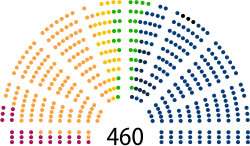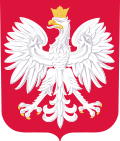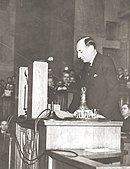Sejm
Sejm of the Republic of Poland Sejm Rzeczypospolitej Polskiej | |
|---|---|
PO since 13 December 2023 | |
| Structure | |
| Seats | 460 deputies (231 majority) |
 | |
Political groups | Government (242)
Opposition (217) |
| Committees | 29
|
| Elections | |
Sejm and Senate Complex, Warsaw | |
| Website | |
| sejm | |
| Footnotes | |
| a 8% for coalitions, 0% for ethnic minority electoral committees | |
The Sejm (Polish: [sɛjm] ⓘ), officially known as the Sejm of the Republic of Poland (Polish: Sejm Rzeczypospolitej Polskiej), is the lower house of the bicameral parliament of Poland.
The Sejm has been the highest governing body of the
In the
During the existence of the
History
Kingdom of Poland

Sejm (an ancient
Following the 1493 Sejm in
Polish–Lithuanian Commonwealth
 |
|---|
The
The 1573
Until the end of the 16th century,
The liberum veto was abolished with the adoption of the Constitution of 3 May 1791, a piece of legislation which was passed as the "Government Act", and for which the Sejm required four years to propagate and adopt. The constitution's acceptance, and the possible long-term consequences it may have had, is arguably the reason that the powers of Habsburg Austria, Russia and Prussia then decided to partition the Polish–Lithuanian Commonwealth, thus putting an end to over 300 years of Polish parliamentary continuity. It is estimated that between 1493 and 1793, a Sejm was held 240 times, the total debate-time sum of which was 44 years.[1]
Partitions
After the fall of the Duchy of Warsaw, which existed as a Napoleonic client state between 1807 and 1815, and its short-lived Sejm of the Duchy of Warsaw, the Sejm of Congress Poland was established in Congress Poland of the Russian Empire; it was composed of the king (the Russian emperor), the upper house (Senate), and the lower house (Chamber of Deputies). Overall, during the period from 1795 until the re-establishment of Poland's sovereignty in 1918, little power was actually held by any Polish legislative body and the occupying powers of Russia, Prussia (later united Germany) and Austria propagated legislation for their own respective formerly-Polish territories at a national level.[1]
-
Tadeusz Rejtan tries to prevent the legalisation of the first partition of Poland by preventing the members of the Sejm from leaving the chamber (1773). Painting by Jan Matejko
Congress Poland
The Chamber of Deputies, despite its name, consisted not only of 77 envoys (sent by local assemblies) from the hereditary nobility, but also of 51 deputies, elected by the non-noble population. All deputies were covered by Parliamentary immunity, with each individual serving for a term of office of six years, with third of the deputies being elected every two years. Candidates for deputy had to be able to read and write, and have a certain amount of wealth. The legal voting age was 21, except for those citizens serving in the military, the personnel of which were not allowed to vote. Parliamentary sessions were initially convened every two years, and lasted for (at least) 30 days. However, after many clashes between liberal deputies and conservative government officials, sessions were later called only four times (1818, 1820, 1826, and 1830, with the last two sessions being secret). The Sejm had the right to call for votes on civil and administrative legal issues, and, with permission from the king, it could also vote on matters related to the fiscal policy and the military. It had the right to exercise control over government officials, and to file petitions. The 64-member Senate on the other hand, was composed of voivodes and kasztelans (both types of provincial governors), Russian envoys, diplomats or princes, and nine bishops. It acted as the Parliamentary Court, had the right to control "citizens' books", and had similar legislative rights as did the Chamber of Deputies.[1]
Germany and Austria-Hungary
In the
In the second half of the 19th century, Poles were able to become members of the parliaments of Austria, Prussia and Russia, where they formed Polish Clubs. Deputies of Polish nationality were elected to the Prussian Landtag from 1848, and then to the German Empire's Reichstag from 1871. Polish Deputies were members of the Austrian State Council (from 1867), and from 1906 were also elected to the Russian Imperial State Duma (lower chamber) and to the State Council (upper chamber).[1]
Second Polish Republic
After the
During the
The legal content of the March Constitution allowed for Sejm supremacy in the system of state institutions at the expense of the executive powers, thus creating a parliamentary republic out of the Polish state. An attempt to strengthen executive powers in 1926 (through the August Amendment) proved too limited and largely failed in helping avoid legislative grid-lock which had ensued as a result of too-great parliamentary power in a state which had numerous diametrically-opposed political parties sitting in its legislature. In 1935, the parliamentary republic was weakened further when, by way of,
On 2 September 1939, the Sejm held its final pre-war session, during which it declared Poland's readiness to defend itself against invading German forces. On 2 November 1939, the President dissolved the Sejm and the Senate, which were then, according to plan, to resume their activity within two months after the end of the Second World War; this, however, never happened. During wartime, the National Council (1939–1945) was established to represent the legislature as part of the
-
Stanisław Dubois speaking to envoys and diplomats in the Sejm, 1931
-
Józef Beck, Minister of Foreign Affairs, delivers his famous Honour Speech in the Sejm, 5 May 1939.
Polish People's Republic
The Sejm in the Polish People's Republic had 460 deputies throughout most of its history. At first, this number was declared to represent one deputy per 60,000 citizens (425 were elected in 1952), but, in 1960, as the population grew, the declaration was changed: The constitution then stated that the deputies were representative of the people and could be recalled by the people, but this article was never used, and, instead of the "five-point electoral law", a non-proportional, "four-point" version was used. Legislation was passed with majority voting.
Under the
The Sejm voted on the budget and on the periodic
The Sejm also chose a
When the Sejm was not in session, the State Council had the power to issue decrees that had the force of law. However, those decrees had to be approved by the Sejm at its next session.[4] In practice, the principles of democratic centralism meant that such approval was only a formality.
The Senate was abolished by the referendum in 1946, after which the Sejm became the sole legislative body in Poland.[1] Even though the Sejm was largely subservient to the Communist party, one deputy, Romuald Bukowski (an independent) voted against the imposition of martial law in 1982.[6]
Third Polish Republic
After the
Between 7 and 20 deputies are elected from each constituency using the d'Hondt method (with one exception, in 2001, when the Sainte-Laguë method was used), their number being proportional to their constituency's population. Additionally, a threshold is used, so that candidates are chosen only from parties that gained at least 5% of the nationwide vote (candidates from ethnic-minority parties are exempt from this threshold).[1]
-
The Sejm building in Warsaw
-
The Sejm's main hall
-
Sessions chamber in the Sejm
-
Sessions chamber viewed from the rostrum
-
Marshal's chair in the sessions chamber
-
Column hall in the Sejm
Historical composition of the Sejm
Second Republic (1918–1939)
| |||||||||||||||||||||||
1919
|
| ||||||||||||||||||||||
1922
|
| ||||||||||||||||||||||
1928
|
| ||||||||||||||||||||||
1930
|
| ||||||||||||||||||||||
1935
|
| ||||||||||||||||||||||
1938
|
| ||||||||||||||||||||||
PRL (1945–1989)
| ||||||||||||||||
1947
|
| |||||||||||||||
1952
|
| |||||||||||||||
1957
|
| |||||||||||||||
1961
|
| |||||||||||||||
1965
|
| |||||||||||||||
1969
|
| |||||||||||||||
1972
|
| |||||||||||||||
1976
|
| |||||||||||||||
1980
|
| |||||||||||||||
1985
|
| |||||||||||||||
1989
|
| |||||||||||||||
Third republic (since 1989)
| ||||||||||||||||||||||||||
| 1991 |
| |||||||||||||||||||||||||
| 1993 |
| |||||||||||||||||||||||||
| 1997 |
| |||||||||||||||||||||||||
| 2001 |
| |||||||||||||||||||||||||
| 2005 |
| |||||||||||||||||||||||||
| 2007 |
| |||||||||||||||||||||||||
| 2011 |
| |||||||||||||||||||||||||
| 2015 |
| |||||||||||||||||||||||||
| 2019 |
| |||||||||||||||||||||||||
| 2023 |
| |||||||||||||||||||||||||
Standing committees
The Sejm has several
- Administration and Internal Affairs
- Agriculture and Rural Development
- Constitutional Accountability
- Culture and Media
- Deputies' Ethics
- Digitization, Innovation and Modern Technology
- Economy and Development
- Education, Science and Youth
- Energy, Climate and State Assets
- Environment Protection, Natural Resources and Forestry
- European Union Affairs
- Foreign Affairs
- Health
- Infrastructure
- Justice and Human Rights
- Legislative
- Liaison with Poles Abroad
- Local Self-Government and Regional Policy
- Maritime Economy and Inland Navigation
- National and Ethnic Minorities
- National Defense
- Petition
- Physical Education and Sport
- Public Finances
- Rules and Deputies' Affairs
- Senior Policy
- Social Policy and Family
- Special Services
- State Control
Extraordinary committees
- For changes in codification
- To consider draft laws regarding the right to terminate pregnancy
Investigative committees
- To investigate the legality, correctness, and purposefulness of actions taken with the goal of preparing and holding the Polish Presidential Elections in 2020 in the form of postal voting
- To investigate the legality, correctness and purposefulness of actions, as well as the occurrence of abuse, neglect, and omissions regarding the legalisation of stay for foreigners within the territory of the Republic of Poland between 12 November 2019 and 20 November 2023
- To investigate the legality, correctness, and purposefulness of operational and reconnaissance activities taken among others with the use of the "Pegasus" software by the members of the council of ministers, special forces, police, tax control authorities and customs control authorities, bodies established to prosecute criminals, and the proscecutor's office between 16 November 2015 and 20 November 2023
Current standings
| Affiliation | Deputies (Sejm) | Senators (Senate) | |||||
|---|---|---|---|---|---|---|---|
| Results of the 2023 election |
As of 16 April 2025 |
Change | Results of the 2023 election |
As of 16 April 2025 |
Change | ||
| Parliamentary clubs | |||||||
Law and Justice |
194 | 190 | 34 | 34 | |||
| Civic Coalition | 157 | 157 | 41 | 41 | |||
| Poland 2050 | 33 | 32 | 11 | 12 | |||
| Polish People's Party | 32 | 32 | |||||
| The Left | 26 | 21 | 9 | 9 | |||
| Deputative clubs | |||||||
Confederation |
18 | 16 | — | — | |||
| Deputative circles | |||||||
Razem |
— | 5 | — | — | |||
| Free Republicans | — | 4 | — | — | |||
| Senatorial circles | |||||||
| Independents and Locals | — | — | — | 3 | |||
| Independents | |||||||
| Independents | — | 3 | 5 | — | |||
| Total members | 460 | 460 | 100 | 100 | |||
| Vacant | — | 0 | — | 0 | |||
| Total seats | 460 | 100 | |||||
See also
- Electoral districts of Poland (1935–39)
- Polish constitutional crisis, 2015
Types of sejm
- Confederated sejm (Sejm skonfederowany)
- Convocation sejm(Sejm konwokacyjny)
- Coronation sejm(Sejm koronacyjny)
- Election sejm(Sejm elekcyjny)
- National Assembly of the Republic of Poland(Zgromadzenie Narodowe)
- Sejmik
- Voivodeship sejmik (Sejmik wojewódzki)
Notable sejms
- Silent Sejm (Sejm Niemy 1717)
- Convocation Sejm (1764)(Sejm konwokacyjny)
- Repnin Sejm (Sejm Repninowski 1767–1768)
- Partition Sejm (Sejm rozbiorowy 1773–1776)
- Great Sejm (Sejm Wielki 1788–1792)
- Grodno Sejm (Sejm grodzieński 1791)
- Silesian Sejm(Sejm Śląski 1920–1939)
- Contract Sejm (Sejm Kontraktowy 1989)
Notes
- ^ Though the by-laws of the Sejm do not mention such a position, the leader of the largest opposition party is called leader of the opposition by convention.[citation needed]
- ^
- ^ Marek Biernacki
- ^
- PSL (28)
- CdP (3)
- Independent (1)[c]
- ^ Daria Gosek-Popiołek, Dorota Olko, Joanna Wicha
- ^
- NL (18)
- Independent (3)[e]
- ^ Adam Gomoła elected on Third Way list
- ^
- PiS (181)
- ONRP (6)
- Independent (3)
- Andrzej Zapałowski
- ^
- NN (8)
- RN (7)
- Independent (1)[i]
- ^
- ^
- KKP (2)
- ^ PSL was a left-wing party until about 2008,[7] and shifted towards the centre-right afterwards.[8]
References
- ^ a b c d e f g h "Poznaj Sejm". opis.sejm.gov.pl. Archived from the original on 15 October 2019. Retrieved 16 June 2013.
- ^ Davies, Norman (1982). God's Playground: A History of Poland. Columbia University Press. p. 302.
- ^ Strauss, Herbert Arthur (1993). Hostages of Modernization: Studies on Modern Antisemitism, 1870-1933/39. Walter de Gruyter. p. 985.
- ^ a b Chapter 3 of 1952 Constitution
- ^ Poland: a country study. Library of Congress Federal Research Division, December 1989.
- ^ The Associated Press (22 October 1992). "Romuald Bukowski; Polish Legislator, 64". The New York Times.
- ^ Gerber, Alexandra (2011). Being Polish/Becoming European: Gender and The Limits of Diffusion in Polish Accession to the European Union (PDF) (Doctor of Philosophy (Sociology) thesis). Ann Arbor, Michigan: University of Michigan. p. 167.
- ^ Szustakiewicz, Przemysław (2010). "Ideologia Polskiego Stronnictwa Ludowego na początku XXI wieku". Studia Politologiczne (in Polish). 18 (1). Instytut Nauk Politycznych Uniwersytetu Warszawskiego: 232.
- ^ "Komisje stałe - Sejm Rzeczypospolitej Polskiej". www.sejm.gov.pl. Retrieved 28 January 2024.
- ^ "Komisje nadzwyczajne - Sejm Rzeczypospolitej Polskiej". www.sejm.gov.pl. Retrieved 28 January 2024.
- ^ "Komisje śledcze - Sejm Rzeczypospolitej Polskiej". www.sejm.gov.pl. Retrieved 28 January 2024.










